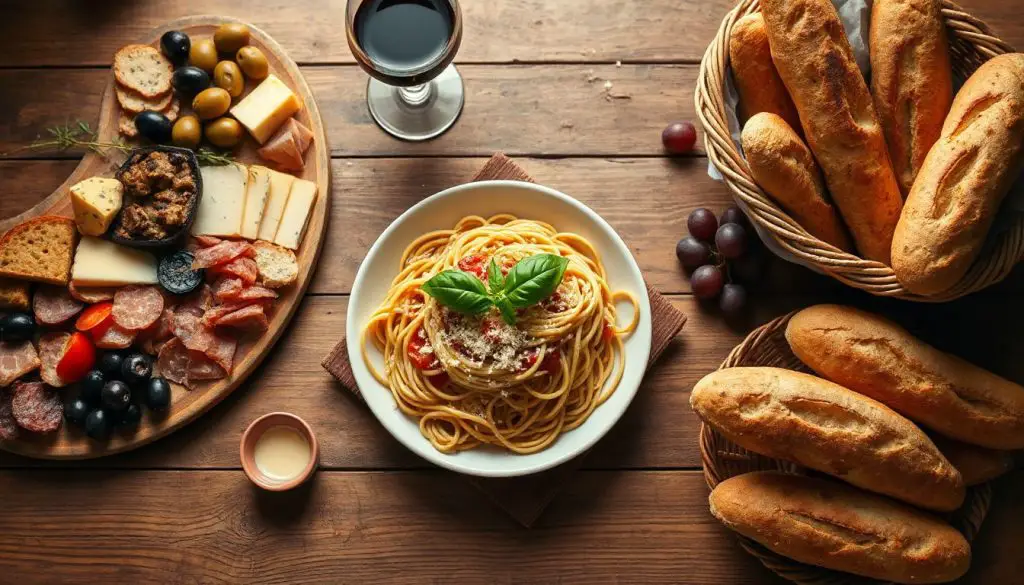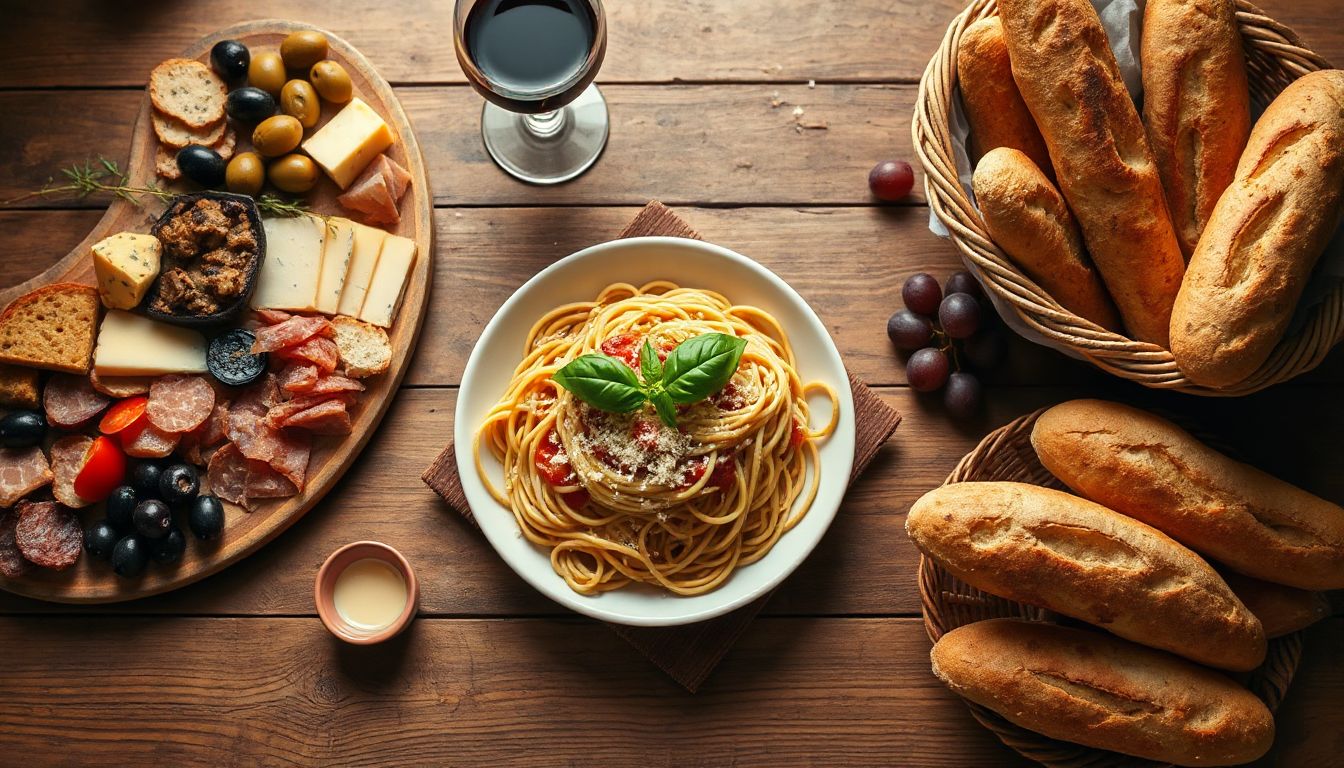Exploring the Rich Tapestry of European Food Culture: A Culinary Journey

The allure of Europe extends far beyond its historical landmarks and diverse landscapes. It’s deeply embedded in its vibrant food culture. From the rustic charm of Italian trattorias to the sophisticated bistros of France and the hearty taverns of Germany, European cuisine offers a sensory exploration of history, tradition, and regional identity. This article delves into the multifaceted food cultures defining the continent. It highlights what makes each bite a unique experience.
European food is not merely sustenance. It serves as a cornerstone of social gatherings, family traditions, and national pride. Understanding these culinary landscapes reveals much about the people, their values, and their connection to the land. We’ll uncover the ingredients, techniques, and philosophies shaping everyday meals and celebratory feasts across Europe.
The Mediterranean Diet: A Foundation of Health and Flavor
The Mediterranean diet offers a proven way to eat for long-term well-being. This eating pattern is prominent in southern European countries. It emphasizes fresh, wholesome foods and traditional cooking methods. Its historical roots connect deeply to the agricultural practices of the region for centuries.
Pillars of the Mediterranean Diet
Core components of this diet include generous use of olive oil. Fresh fruits and vegetables are central to almost every meal. Whole grains, legumes, nuts, and seeds provide essential nutrients. Fish is consumed often, though in moderation. Red meat and dairy are eaten in limited amounts. This focus on plant-based foods makes for a balanced and flavorful eating style.
Regional Variations in Mediterranean Cuisine
Across the Mediterranean, unique culinary traditions thrive within this healthy framework. Greek cuisine often features feta cheese, olives, and lamb, seen in dishes like moussaka. Italian food brings pasta, tomatoes, and basil to the forefront, creating iconic meals such as lasagna. Spanish cooking showcases paella with seafood and saffron. Portuguese dishes highlight codfish and grilled sardines. Each country offers its own distinct spin on the Mediterranean way of eating.
Health Benefits and Scientific Backing
Eating a Mediterranean-style diet offers many long-term health advantages. Studies consistently show a reduced risk of cardiovascular disease. Experts often recommend this diet for its positive effects on heart health. Its focus on natural, unprocessed foods helps manage blood pressure and cholesterol levels. This makes it a globally recognized model for healthy living.
French Gastronomy: Elegance, Technique, and Terroir
French cuisine is known around the world for its great sophistication. It places a strong emphasis on precise cooking techniques. The connection to specific regions, or “terroir,” makes French food truly special. Each area offers unique ingredients and flavors, shaping local dishes.
The Art of French Cooking: Techniques and Classics
Foundational techniques like mise en place (everything in its place) are crucial in French kitchens. Classic sauces, such as béchamel and hollandaise, form the basis of many dishes. Pastry making is an art form, demanding skill and patience. Braising meats slowly creates tender, rich flavors. Iconic dishes like coq au vin, chicken simmered in red wine, and boeuf bourguignon, a beef stew, show this culinary mastery.
Regional Culinary Stars: From Alsace to Provence
France boasts diverse regional specialties. In Alsace, tarte flambée, a thin crust pizza-like dish, is a local favorite. Provençal ratatouille combines summer vegetables in a flavorful stew. Breton crêpes offer sweet or savory fillings. Lyon, a city famous for its food, presents quenelles, light fish dumplings. Each region’s food tells a story of its land and people.
The French Wine and Cheese Pairing Culture
Wine and cheese are deeply integrated into French meals. They are more than just food items; they are a way of life. Popular wine varietals include Cabernet Sauvignon and Chardonnay. Many types of cheese, like Brie and Roquefort, come from specific regions. Understanding these pairings enhances the dining experience. It highlights the distinct tastes of France.
German and Austrian Culinary Traditions: Hearty, Comforting, and Celebratory
German and Austrian food traditions are all about robust flavors. They focus on seasonal ingredients and hearty meals. Bread, sausages, and beer play very important roles in both countries’ food cultures. These foods often bring people together for celebrations and everyday gatherings.
The Ubiquitous Sausage and Bread Culture
Germany and Austria feature an incredible variety of sausages, known as Wurst. From the grilled Bratwurst to the white Weisswurst of Bavaria, each region has its own specialty. Bread is also a cultural cornerstone. Bakeries offer countless types of dark rye, sourdough, and soft rolls. These staples are enjoyed at almost every meal.
Hearty Main Courses and Comfort Food
Main courses are typically filling and satisfying. Schnitzel, a thin, breaded cutlet, is a classic favorite. Sauerbraten, a marinated roast, offers rich, savory tastes. In Austria, Goulash is a popular, flavorful stew. Various potato preparations, like dumplings or roasted potatoes, often accompany these dishes. They provide true comfort.
Beer Gardens, Festivals, and Culinary Gatherings
Food and drink are highly social in Germany and Austria. Beer gardens serve as meeting places for friends and family. Festivals like Oktoberfest celebrate beer and traditional foods on a grand scale. Christmas markets offer seasonal treats and warm drinks. These events highlight the communal joy of eating and drinking together.
Eastern European Flavors: Richness, Spices, and Shared Heritage
Eastern Europe presents a diverse culinary scene. It features rich flavors, distinct spices, and a shared historical heritage. Many countries in this region have similar dishes, yet each adds its own special twist.
Eastern European Staples: Pierogi, Goulash, and Cabbage Rolls
Signature dishes often cross national borders. Polish pierogi, filled dumplings, are a beloved comfort food. Hungarian goulash is a paprika-rich stew, warming and hearty. Romanian sarmale, or cabbage rolls, show the use of preserved vegetables. These dishes are central to family tables across the region.
The Importance of Fermentation and Preservation
Traditional methods of food preservation are key in Eastern Europe. Fermentation helps keep food through long winters. Pickling vegetables like cabbage for sauerkraut and cucumbers is common. Fermenting dairy also creates tangy yogurts and cheeses. These techniques give distinct flavors and extend the life of ingredients.
Influences from Russia, Poland, Hungary, and the Balkans
Each nation contributes unique dishes and ingredients. Russian borscht, a beet soup, is known for its deep color and flavor. Hungarian cuisine uses paprika extensively, adding a vibrant kick to many dishes. The Balkans are famous for grilled meats, often seasoned with strong spices. These regional touches create a rich and varied culinary experience.
Nordic Cuisine: A Renaissance of Simplicity and Sustainability
Nordic cuisine has seen a modern shift towards fresh, local, and seasonal ingredients. This movement, often called New Nordic cuisine, combines tradition with innovation. It focuses on purity and sustainability, reflecting the region’s clean environment.
New Nordic Cuisine: Embracing Local and Seasonal
Chefs like René Redzepi from Noma have led this movement. They emphasize foraging for wild ingredients. Local sourcing is paramount, using what the land and sea provide. Innovative techniques transform simple ingredients into complex flavors. This approach celebrates the unique tastes of the Nordic landscape.
Traditional Nordic Staples: Fish, Rye, and Root Vegetables
Historically, fish has been a vital part of the Nordic diet. Herring and salmon are particularly important. Rye bread, or rugbrød in Denmark, is a dense and hearty staple. Root vegetables like potatoes, carrots, and beets thrive in the northern climate. These foods form the bedrock of Nordic cooking.
Smørrebrød and Hygge: Food as a Social Experience
The Danish open-faced sandwich, smørrebrød, is a classic lunch item. It shows off fresh ingredients and careful presentation. The concept of hygge (hoo-gah) is also central. It describes a feeling of coziness and comfort. Food often plays a major role in creating this warm, connected atmosphere among friends and family.
Actionable Tips for Exploring European Food Culture
Experiencing European food firsthand can be a memorable adventure. Use these tips to deepen your culinary exploration. Each suggestion helps you connect more closely with local traditions and flavors.
Embrace Local Markets and Delis
Visit farmers’ markets and food halls wherever you travel. These vibrant places offer fresh, regional products. Talk to local vendors; they often share great insights. Discovering unique cheeses, cured meats, and fresh produce becomes part of the fun.
Seek Out Traditional Eateries and Bistros
Look for authentic, family-run restaurants. These places often serve the best local cuisine. Avoid overly touristy spots. Ask locals for their favorite hidden gems. You’ll likely find genuine flavors and a warm atmosphere.
Participate in Food Tours and Cooking Classes
Guided food tours let you taste a range of local specialties. They also teach you about culinary history. Cooking classes provide a hands-on experience. Learn traditional techniques and the stories behind famous dishes. This makes for a truly immersive experience.
Conclusion
The food culture in European countries is incredibly diverse and rich. It mirrors the continent’s long history, varied geography, and vibrant social life. From the healthy principles of the Mediterranean diet to the refined techniques of French gastronomy, every region offers a unique culinary story. These traditions are more than just meals; they are woven into the fabric of daily life.
Embark on your own culinary adventures across Europe. Appreciate the stories and traditions behind every meal. Each dish offers a connection to the past and a taste of local identity. Find joy in exploring the flavors that make Europe a global food destination.








